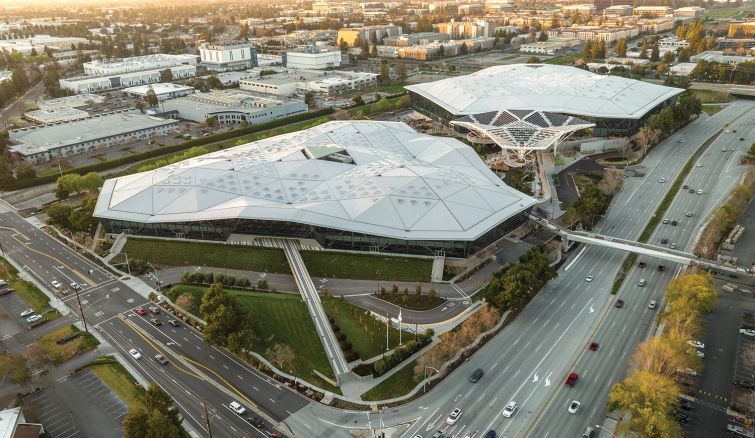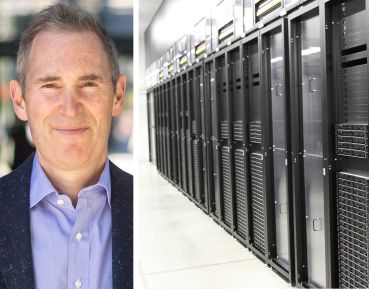Tech Giant NVIDIA Embraced Remote Work. It’s Worth $1 Trillion.
Its success in powering the AI boom stems partly from a culture different from most tech giants
By Patrick Sisson October 10, 2023 8:00 am
reprints
Silicon Valley tech darling NVIDIA, a chip and graphics hardware manufacturer whose products power much of the artificial intelligence boom, named the latest addition to its $902 million headquarters Voyager, in reference to a “Star Trek” spaceship.
And, yet, one decision that propelled the firm to become one of the most valuable companies on the planet — helping it boldly go where no one has gone before — is its embrace of its workers staying in place.
As one of the world’s biggest tech companies, this decision to embrace — not just allow, but fully institute — the flexibility of remote work while maintaining top-tier offices for collaboration and meetings “creates a pretty meaningful talent advantage,” argues Rob Sadow, CEO and co-founder of Scoop Technologies, which sells an app focused on hybrid office productivity (and which does not work with NVIDIA).
It also sets a standard, despite pandemic-era pullbacks and property sales, since tech still represents a significant portion of overall office leasing.
NVIDIA’s setup has made it an outlier among tech giants. Google, Apple and even Zoom have pushed workers to return to the office; earlier this year, Amazon CEO Andy Jassy told employees there may not be a future for them if they don’t want to return, though he himself had no data to offer in support of the return-to-office mandate.
These firms practice structured hybrid working arrangements, with specific expectation on time spent in the office, most commonly two or three days minimum (65 percent of tech firms over 25,000 employees do so, per Scoop data). NVIDIA, on the other hand, operates on what it sometimes calls an “employee’s choice” arrangement, which lets workers and teams decide how often they come into the office and collaborate in person.
In 2020, NVIDIA CEO Jensen Huang simply said he has “no problem with it,” and hasn’t changed policy since. The firm maintains “a flexible work environment for employees worldwide,” said Beau Davidson, vice president of employee experience at NVIDIA, who wouldn’t share how many of the firm’s 26,000-strong global workforce are remote. Employees work with their managers to find the right balance for them and their job, and, if an employee’s needs change over time, the standard is to remain flexible.
NVIDIA’s unique strategy and market acumen, embodying the corporate mantra of moving at the “speed of light,” helped it seize opportunities in gaming, self-driving vehicles and AI on its way to a trillion-dollar market capitalization. Its growth has only accelerated. It posted jaw-dropping second-quarter revenues of $13.51 billion this year, a 100 percent jump from the same time last year, and a sharp contrast from other tech firms, many of which are struggling. The company’s culture and philosophy also appear to carry over to its approach to human resources, workplace policy and real estate strategy.
“I think it’s NVIDIA betting on their talent and their culture,” said Scoop’s Sadow. “It’s saying, ‘We think we can make the model work, we’ve got the leadership paradigm in place to do it.’ ”
NVIDIA believes it’s both an attraction and retention advantage. The firm views its flexible work arrangement “as a way for employees to balance their personal and work obligations, while preparing for the future, so they can focus on doing their life’s work,” said Davidson.
NVIDIA in particular focuses on software and hardware engineers. Its powerful Compute Unified Device Architecture, which makes its products so flexible and powerful, basically adds an AI-powered software stack on top of high-powered microchips. These are two of the most highly sought-after types of tech talent today, and those that tend to demand the flexibility to work remotely, said Colin Yasukochi, executive director of CBRE (CBRE)’s San Francisco-based Tech Insights Center. Allowing new hires from anywhere to get started as soon as possible provides a big advantage during the current AI hiring spree.
At the same time, having a large home base for training and collaboration bolsters the firm’s focus on research and development. NVIDIA invests 27 percent of its sales in R&D.
“While we don’t disclose specific numbers, we’re seeing a healthy and growing flow of employees coming on campus for meetings, customer visits, projects, volunteer events and other opportunities to connect with peers,” said NVIDIA’s Davidson.
NVIDIA is likely the fastest-growing large tech firm taking this remote-forward approach, but others have similar policies. LinkedIn, Microsoft and Airbnb have also given employees wide latitude to work outside the office. Insurance firm Allstate, which adopted employee preference for its workforce of over half a million, has since offloaded its headquarters and cut its real estate footprint in half, saving $159 million since 2020.
Atlassian, a global firm focused on collaboration software programs such as Jira, has had employee choice since August 2020, creating a significantly distributed company. The 11,000-employee workforce lives in 13 countries, and 40 percent of employees live more than two hours from an office. Annie Dean, who oversees Atlassian’s real estate and workplace experience, said the firm’s “team anywhere” approach has meant that remote hires — those who live two-plus hours from an office — went from 14 percent in 2020 to 54 percent in 2023.
Atlassian has also revamped its real estate strategy based on measuring new metrics, such as cost per visit, visitor engagement and utilization. This analysis led to plans to open an office in Seattle in February 2024, to accommodate a fast-growing population in nearby Bellevue. The company also broke ground for a new 40-story Sydney, Australia, HQ designed around collaborative spaces and accommodating large teams arriving for meetups
“When you treat your offices like a product, meaning you ensure that it meets the needs of your users, you can drive operational efficiency and ROI for your offices, while still providing employees with flexibility to choose where they can work best every day,” Dean said.
NVIDIA’s strategy also appears aligned with the general state of the Silicon Valley and San Francisco Bay Area tech office markets. The firm wouldn’t comment on real estate decisions, but said it was seeking to fill 750-plus open roles in Santa Clara, Calif. Despite dark portents of the state of Bay Area office properties, regional tech leasing has rebounded, according to CBRE’s Yasukochi, recovering from a low point in the fourth quarter of 2022.
AI will be a long-term growth factor for office demand and a new anchor industry for the region, Yasukochi said. The hype over and focus on generative AI by industry leaders and startups is clear, and this subsector of the industry is quadrupling its overall footprint. The true, large-scale impact on corporate growth and occupancy won’t be felt for years. But in the meantime, Yasukochi said that AI firms, due to the newness of their technology, tend to have larger space requirements for collaboration.
Still, with so much office vacancy — San Francisco hit a record 33.9 percent in the second quarter — it’s unlikely tech firms will be engaging in land grabs and massive headquarters developments. Office requirements are shrinking. Yasukochi said firms used to benchmark about 150 square feet per employee, and that number has shrunk considerably. He said that even the most optimistic scenario would find the market hitting pre-pandemic levels of tech office activity in a few years at minimum.
NVIDIA’s new Santa Clara headquarters — a dizzying, spiraling campus filled with triangles, a reference to the shape that forms the building blocks of computer graphics displays — may be one of the last of the spaceship-style tech offices to take shape in the Valley for some time. The future will likely be more targeted, more gradual, leasing a few floors at a time in more flexible office space adjacent to Bay Area mass transit. NVIDIA itself appeared to follow that strategy in July of 2022, leasing about 102,000 square feet at an office park near its HQ.
“It’s not like I need an office or I don’t need an office. It’s a question of square footage and setup,” said Sadow. “My guess is that a lot more of NVIDIA’s space over time is going to look like collaborative space or lab-type space.”
NVIDIA’s strategy, rooted in collaboration spaces and employee flexibility, seems to be more about what’s coming next. Sadow said a significant number of smaller startups, especially those formed in the last few years, are remote-first or don’t even have an office, with 88 percent of all firms under 500 employees going fully remote. The younger a firm is, the more likely it is to favor remote or home-based work. It’ll lead to a new generation of tech executives who will have never worked under a traditional office-first policy, continually pushing the industry to focus on remote-friendly policies.
Larger tech firms that focus on bringing employees back are falling back on past patterns in lieu of current challenges, Sadow argued. Even the language of return-to-office mandate announcements sounds stressed, often referencing how companies need to hunker down and collaborate to face a really important chapter in front of the firm. NVIDIA’s message, on the other hand, seems to be: We’re growing like a rocketship, and need to scale and expand to meet the moment.
“Sometimes that desire to return to office comes more out of fear and desire to repeat past experience than it is around optimizing for what the future is going to look like,” Sadow said.



